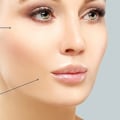First introduced to the market in 1989, the original injectable Botox has become ubiquitous because of its ability to “freeze faces and stop time, or at least look like it”. In the decades since its introduction, this remarkable agent has literally changed the face of humanity. Dr. William Truswell, board certified in otolaryngology and facial plastic and reconstructive surgery, is president of the American Board of Facial Plastic and Reconstructive Surgery. Most people associate botulinum toxin injections with treating wrinkles; however, this versatile agent is used for many other conditions, including spasticity, eye twitching (i.e.
blepharospasm), and even migraines. The story of how we came to inject this microbial toxin into our bodies to treat wrinkles is fascinating and fortuitous. Clostridium botulinum comes in several strains, eight serotypes A, B, C1, C2, D, E, F and G; only serotypes A and B are used to create clinical preparations. After injection into the muscle, botulinum toxin permeates the nerve terminal and binds, thus preventing the release of acetylcholine, a neurotransmitter. This focal or site-specific paralysis is what smooths wrinkles and stops spasms.
In other words, botulinum toxin works by paralyzing wrinkles. In addition to interfering with the release of acetylcholine, botulinum toxin also interferes with the release of pain and inflammatory mediators, including substance P and glutamine; this explains why botulinum toxin is used to treat migraines. Side effects after treatment with botulinum toxin include bruising, swelling, headaches, muscle aches and weakness that can affect the muscles surrounding the muscle that was injected. Pain at the injection site can be minimized with the use of a small gauge needle, the application of a topical anesthetic or the application of ice to the area prior to the injection. Botulinum toxin effects wear off over time; specifically, after initial chemical denervation, nerve endings sprout or regenerate and functionality is restored after altering the nerve ending.
Botulinum toxin functions for approximately four to six months before nerves regenerate. In a few individuals, the standard dose will not produce the desired result; in such cases a second dose can be administered. Botulinum toxin type A is now manufactured by four independent pharmaceutical companies under the trade names Botox Cosmetic, Dysport, Xeomen and Jeuveau. While each has minor differences, the active ingredient in all is botulinum toxin and they all work essentially the same way. Clostridium botulinum was first discovered by a Belgian scientist named Emile Pierre van Ermengem after an outbreak of botulism in Belgium. In the 1920s scientists at the University of California San Francisco tried for the first time to isolate botulinum toxin; however it took 20 years before Botulinum toxin was finally isolated in crystalline form by Dr.
Edward Schantz. In the 1970s scientists began using botulinum toxin to treat strabismus (i.e., crossed eyes). When testing this treatment on monkeys researchers noticed that botulinum toxin reduced wrinkles in the glabella (the skin between the eyebrows and above the nose). After Botulinum toxin was successful in treating strabismus Allergan was the first company to license it as Botox. Subsequently Botox received FDA approval for a variety of medical and cosmetic uses. Keep in mind that although doctors use botulinum toxin to treat many types of facial wrinkles much of this treatment is not indicated on the label; in other words your doctor uses clinical judgment to treat facial wrinkles with Botox. In the annals of medicine botulinum toxin is probably most notable because it was the first microbial injection used to treat diseases; injecting bacterial products into human bodies represents a new invention.
With each passing year researchers develop more formulations of this versatile agent and find more uses for it. Botulinum is a versatile agent that is commonly used to treat many types of wrinkles; in general it is relatively safe with few adverse effects. If you are interested in receiving treatments with botulinum toxin talk to your dermatologist. The Food and Drug Administration (FDA) recently endorsed a widespread cosmetic procedure by approving the use of botulinum toxin type A to temporarily soften frown lines between eyebrows. Botox and fillers as well as newer heat treatments should be repeated sometimes every three to six months. Dr. Eric Putterman who participated in first clinical trials with Botox said there is no data to suggest that patients should limit number of injections they undergo; Allergan says Botox is well established as a drug and that benefits and risks are well known.
He said he still treats some of same patients who started Botox injections 20 years ago and who have not experienced adverse reactions. In doctor's offices where patients often don't see box in which vials are packed and therefore may be unaware of black box warning doctors have responsibility to describe potential risks with any patient who decides to try Botox for any condition approved or not by FDA. In Rosenthal and Finzi research 74 people with major depressive disorder were randomly assigned to receive Botox injections or placebo. Paralyzing muscle activity is how Botox can stabilize lost gaze eliminate eyelid spasm or stop signaling from sweat-stimulating nerves in person's armpit. In this first article in three-part series Ocular Surgery News recounts history of Botox and examines its current applications. In case of Botox doctors who experiment outside what is indicated say they do so because they seek better treatment options for their patients. In addition patients with egg allergy may have higher chance of an allergic reaction since Botox molecule is stabilized with human albumin a protein that is similar to egg albumin Dr. Christa Clark said.


